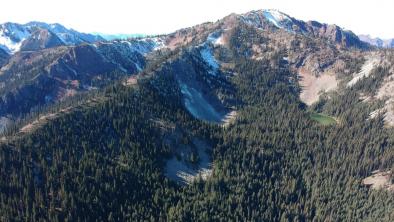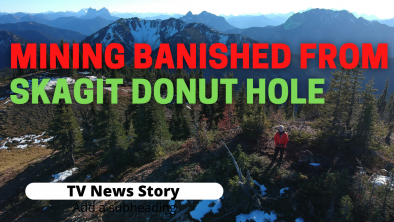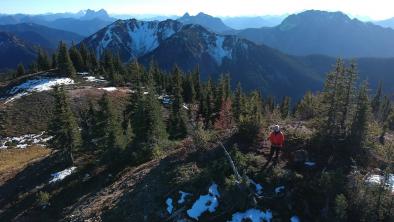Groups call on B.C. to fund Indigenous monitoring of mines in traditional territories
The Narwhal

As the province considers reforms to mining laws, 30 organizations are advocating for increased transparency and more independent enforcement — including an increased role for Indigenous communities to oversee projects approved on their lands
Indigenous-led groups, such as the Indigenous Guardians, should be tasked and funded by the provincial government to keep an eye on mining operations in their territories, the B.C. Mining Law Reform network is recommending to Energy, Mines and Petroleum Resources Minister Michelle Mungall.
The proposal from the network of about 30 local, national and Alaskan organizations, including community groups, First Nations and environmental groups, is among recommendations on government’s proposed changes to the Mines Act, which the group says do not go far enough and fall short of protecting B.C.’s environment and communities from mining risks.
The reform network, a not-for-profit group, was launched this spring to counter problems caused by weak mining laws and lack of enforcement in B.C.
Among nine specific requests to beef up the province’s proposed mining reforms — including calls for greater transparency in environmental monitoring and a more progressive regime of fines and penalties — the group is also calling on government to “enable and fund Indigenous-led monitoring and enforcement programs for mining activities as well as other forms of independent monitoring.”
Community-based programs should train monitoring staff so information collected on mines in the area can be used to help inform management and decision-making, the letter to Mungall suggests.
Allen Edzerza, member of the Tahltan First Nation and representative of the First Nations Energy and Mining Council, said his organization has recently discussed the possibility with senior B.C. officials of training a network of Indigenous monitors across the province in a range of different skills.
“If the function is to monitor mining projects to make sure they’re complying with their licences that requires certain kinds of training,” Edzerza said. “If you’re looking at monitoring forestry and annual allowable cut, that is going to require a different skillset. If you’re monitoring wildlife and hunting regulations, for example, then you’ll need to know those regulations.”
The goal is to work with communities to ensure they have the basics in place to work effectively with the province.
In their letter to Mungall, the group points to Australia’s Indigenous Ranger’s program, the Coastal First Nations’ Guardian Watchmen in B.C., the Peace-Athabasca Delta Ecological Monitoring Program in Alberta as well as the Independent Environmental Monitoring Agency in the Northwest Territories.
Incorporating Indigenous participation within B.C.’s mine management and monitoring would have the added benefit of helping “develop data collection protocols and train community-based monitoring staff so that data generated locally can be used for management, governance, and statutory decision making,” the letter states.
Indigenous guardians are increasing in communities across Canada, through programs designed to protect the land and conducting environmental monitoring.
“First Nation leadership would say that the guardians are viewed as boots on the ground,” Edzerza said, adding that many problems associated with mines, like the leaching Tulsequah Chief mine or the tailings pond collapse at the Mount Polley mine, require regular monitoring, compliance and enforcement.
“We’re saying our communities are right next to these projects. It would make sense that First Nations would perform some of these monitoring and compliance type functions,” he said.
“It’s probably the least expensive and it’s probably the best way to ensure this monitoring is occurring on these projects because we’re the ones who are being impacted. We have the interests and we’re local to it.”

Mining reforms a test case for B.C.’s recognition of Indigenous rights
The reform network’s recommendations are based on a study by the University of Victoria’s Environmental Law Centre, which found that, “For First Nations, community-based monitoring can be an expression of their territorial jurisdiction and self-governance.”
The centre’s paper points to the “fundamental conflict between Indigenous rights and the mining regime in B.C.” with the provincial government failing to recognize the inherent legal rights of First Nations and lax rules that have allowed mining companies to inflict significant environmental harm in traditional territories.
For example, the Tsilhqot’in National Government is continuing to fight Taseko Mines’ plans to mine for copper and gold in a sacred area in their territory and Imperial Metals — the company responsible for the Mount Polley tailings dam collapse — has obtained mineral rights in the sensitive “doughnut hole” between the Skagit Valley and Manning provincial parks.
Indigenous communities on both sides of the Canada/U.S. border are concerned that any mining in the doughnut hole will affect salmon in the Skagit River, but, in the mine exploration permit application for the doughnut hole, Imperial Metals is asked whether there has been engagement with First Nations — the response is “no.”
And, as The Narwhal recently reported, jade placer mining is occurring in northwest B.C. under a provincial permitting regime that is explicitly opposed by the Tahltan Central Government and its customary laws.
The provincial government, which is also in the early stages of looking at changes to the contentious Mineral Tenure Act, announced last week that it is starting on the process of reconciling B.C. laws with the United Nations Declaration on the Rights of Indigenous Peoples (UNDRIP) and mining rules are likely to be near the top of the list.
Edzerza said guardians are tasked with the responsibility of carrying forward traditional knowledge.
“If you take a look at the new legislation tabled with respect to UNDRIP, it’s our belief that the guardian program is going to be absolutely essentially to truly implement those articles that are set out in that legislation,” he said.
Mines Act overhaul an opportunity for Indigenous rights
So far, the overhaul of the Mines Act, which is likely to be introduced in the Legislature next year, is looking at separating permitting and authorizations from enforcement and inspection duties and creating a new oversight body, but pressure is building for more action and any changes will have to adhere to UNDRIP principles.
According to the articles of UNDRIP, Indigenous people have the right to participate in decision-making processes, using their own laws and land tenure systems and that they must give “free, prior and informed consent” before any activity takes place in their traditional territories.
Joe Foy of the Wilderness Committee, one of the groups signing the submission to Mungall, said it would be hard to understand how the provincial government could move forward in retooling its laws without ensuring mining legislation adheres to UNDRIP.
“You would think it would also be important to the mining industry because the history of current events are showing us that distrust in Indigenous communities is making them resistant to mining,” Foy said.
Organizations representing the mining industry say they are not expecting UNDRIP to be a problem.
A statement from Vancouver-based Association for Mineral Exploration said the sector supports the goal of the legislation “to advance reconciliation with First Nations and the objective to reduce uncertainty for users of the land base.”
The industry expects “minimal immediate change” as most companies “are leaders when it comes to building relationships and early engagement with First Nations,” says the media statement.
The Mining Association of B.C. is also cautiously optimistic that the changes will bring greater certainty on the land base.
Other recommendations in the B.C. Mining Law Reform paper include taking mining compliance and enforcement completely out of the jurisdiction of the Mines Ministry and requiring mining companies to provide security that is sufficient to pay for 100 per cent of the cleanup and reclamation costs in addition to paying into a fund to cover the costs of disasters not covered by private insurers.
The ELC estimates that liability costs for old mines in B.C. are $1 billion, while a report from Mining Watch Canada estimates the figure to be closer to $3 billion. In 2016 Carol Bellringer, B.C.’s auditor general, in a damning report, found that mining companies do not post enough security deposits to cover reclamation costs and estimated the fund is short more than $1 billion.
With files from Carol Linnitt.
To view the original article published by The Narwhal please click here.


